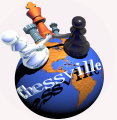|
||||||
|
|
||||||
|
Chessville
Gift Ideas
Green
Regulation
Checkmate
Luxury
Tournament
Place Your Ad Advertise to Single insert:
|
RulesGetting Started
Chess is played on a square board which is sub-divided into 64 squares of alternating light and dark colors. Some of the more common colors used for the chess board squares are white (or off-white) and green, white and black, and tan and brown; but regardless of their actual colors, they are typically referred to as “light” and “dark” or “white” and “black.” The 64 squares of the chess board are arranged in an 8 by 8 grid, the horizontal rows of which are referred to as “ranks”, the vertical columns as “files”, and the diagonal lines as “diagonals.” Chess is played with 32 pieces, divided into two sets of 16 pieces each. Each set of 16 pieces is comprised of one king, one queen, two rooks, two bishops, two knights, and eight pawns. One set is light-colored (most often white or tan) and the other set is dark-colored (most often black or brown); but regardless of their actual colors, they are typically referred to as “white” and “black.” The player who has the white pieces is typically referred to as the white player or just plain “White.” The player who has the black pieces is typically referred to as the black player or just plain “Black.” The player with the white pieces moves first. Moves are alternated until the end of the game. No player may make more than one move per turn, and no player may “pass” or skip a turn: moving is mandatory. For casual games, it is customary to use some random method to decide who gets the white pieces. A common method is for one player to take a different colored pawn in each hand and place them behind his or her back, having the other player choose a hand, and thereby a color. At the start of the game, the pieces are arranged on the board as in the diagram at the top of this page, with each of the two players sitting behind their respective pieces. Notice the following things about this initial position: 1) The board is oriented so that there is a light square in the right corner of the board from each player’s perspective. It is important to orient the board correctly so that the pieces may be placed properly. 2) White’s pieces are arranged thus: on the back rank (closest to the White player) from left to right: rook, knight, bishop, queen, king, bishop, knight, rook. The eight pawns are placed on the eight squares of the second rank. Notice that the white queen stands on a white square: “Queen on color,” as the saying goes. 3) Black’s pieces are arranged likewise on his or her back two ranks. Notice that the black queen stands on a black square: again, “Queen on color.” Next: How the Pieces Move -- General Observations Copyright 2002 S. Evan Kreider. Used with permission.
|
Excalibur
New In Chess
Winning
(Prices are as
The Chessville
The
|
||||
|
||||||












